Menu
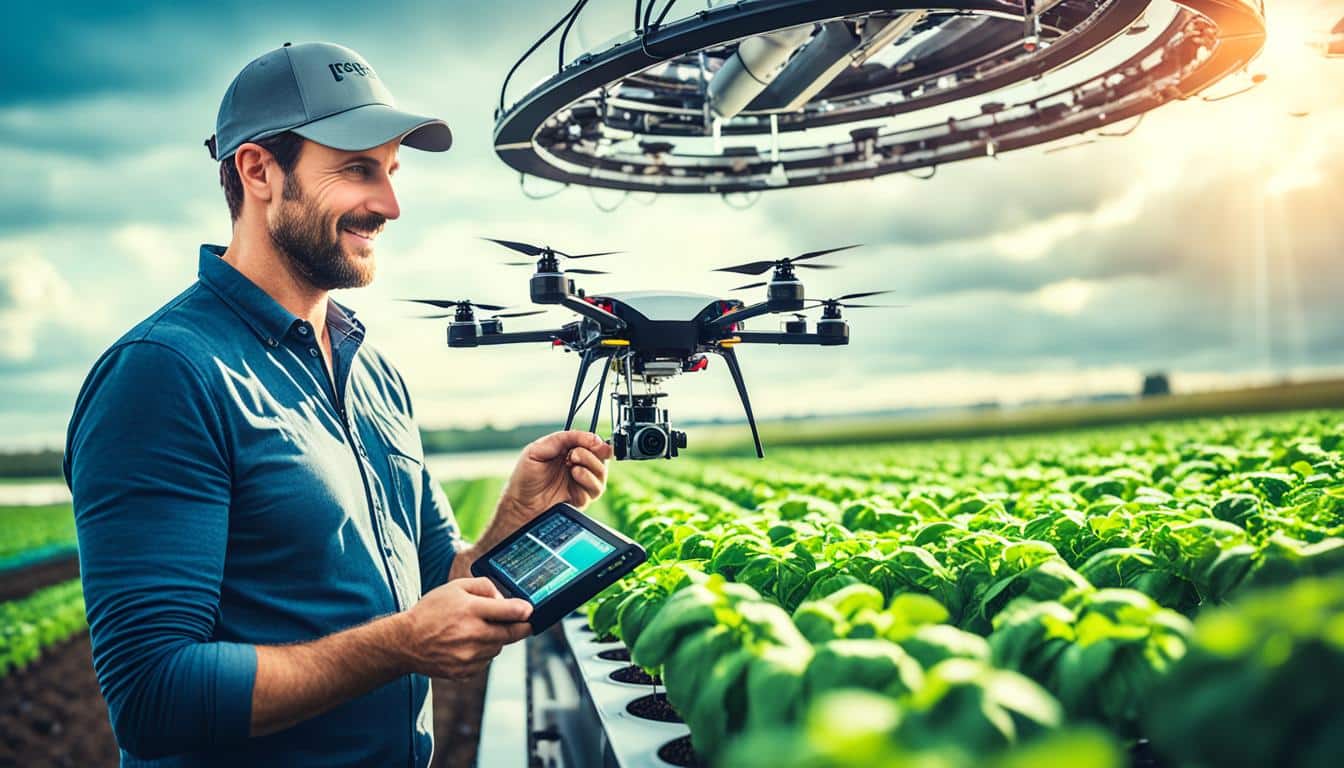
“The future of farming is all about new ideas and the latest tech.” – Dr. Norman Borlaug, Nobel Laureate.
The agriculture world is rapidly changing. It’s at a point where new ideas and sustainability meet. At Misset International, we’re diving into new farming techniques that make agriculture more sustainable. Our work focuses on the newest solutions and technologies, offering key information to everyone in the industry.
The blend of technology and farming is no longer just a dream; it’s vital. By 2050, we need to produce 60% more food for a world with 9.3 billion people. This challenge can be tackled with tech like AI, IoT, and precision farming. A recent report shows a big growth in the global market for smart farming. It went from USD 19.5 billion in 2022 to an estimated USD 53 billion by 2032. This is a 10.5% jump each year for the next ten years.
Misset International is all about pushing for sustainable farming. The global market for smart agriculture is predicted to grow to USD 60.1 billion by 2033. The use of digital farming is steadily growing, at a rate of 11.3% yearly from 2023 to 2033. These numbers show us how much digital agriculture is changing the game. And how important new tech is for switching up old farming methods.
Future farming innovations shape how sustainable our farms are. We’ll have 10 billion people by 2050. It’s key to use digital agriculture and new tech to tackle big issues like food security and climate change.
Feeding the world is a big challenge today. We need to make 60% more food by 2050, says the Food and Agriculture Organization. Innovations like GMO crops help us grow more food. Smart tech in farming saves resources, grows more crops, and cuts costs.
We need eco-friendly farm methods to fight climate change. Digital farming with IoT, sensors, and AI is one such way. It uses less water and land, yet produces more food. Methods like aquaponics in cities show a lot of promise.
| Technique | Description | Benefits |
|---|---|---|
| Aquaponics | Growing plants in water enriched with nutrients from fish waste | High yield, less water, urban applicability |
| Aeroponics | Growing plants in a mist or air environment with added nutrients | High yield, less space, efficient nutrient delivery |
The Food and Agriculture Organization urges us to grow food in eco-friendly ways. It’s crucial to use advanced methods without harming our planet. Now, these techniques are vital for a greener future.
The world of farming is changing fast because of new technology. These changes are making farming better, faster, and kinder to the planet.
Artificial intelligence (AI) is a big reason for these changes in farming. It helps farmers by making their crops grow better and keeping their soil healthy. With AI, farming smartly means you get more crops and you take better care of the earth. AI also helps with keeping away pests, guessing how much crop farmers will get before they do, and even guessing how much food we’ll have later. So, it’s no wonder that AI in farming is becoming more and more important. It’s speeding up how quickly we modernise our farming ways.
Thanks to AI and genetically modified organisms (GMOs), we have used less pesticide by about 8.2%. At the same time, we’ve grown more of our food by 22%. This shows that AI is really working well for the farming business.
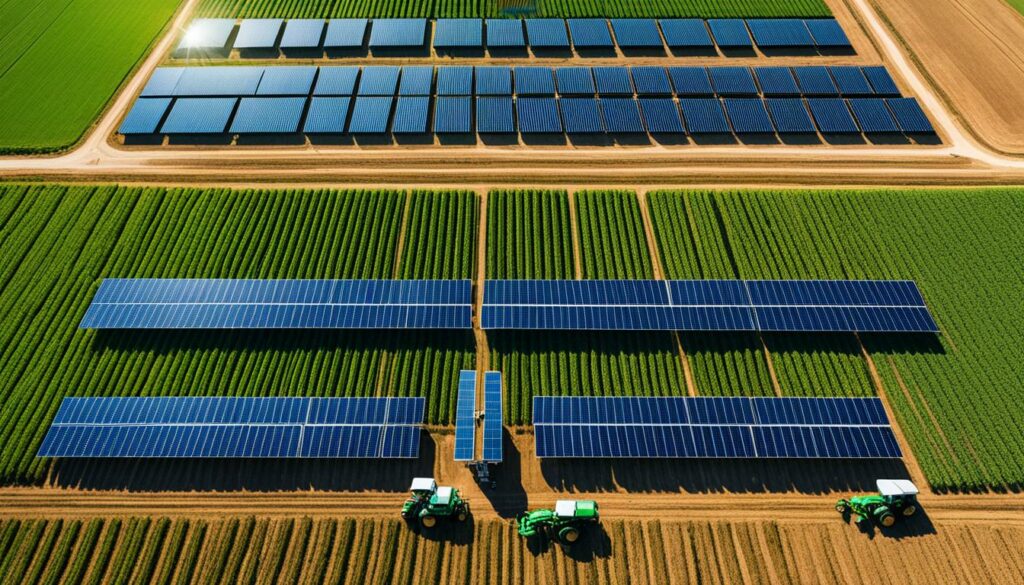
The Internet of Things (IoT) is also making big changes in farming. With the help of IoT, farmers can now do many tasks using smart digital tools. These tools use sensors to watch over crops, making it easier for farmers to guess how much they will produce. For African farmers, this has meant being 30% more accurate in these guesses. Tools like smart water systems are also helping to use water better. This means we get more food using less water.
This move to more technology in farming will add a lot of money to our global economy. By using IoT, it could add over $500 billion to the world’s money by the end of the decade. Right now, only a small part of farms in the U.S. are using smart tools. But this will change soon. By 2030, about 80% of the world’s countryside will be using really smart tech. This will change farming a lot for the better.
Precision farming is changing agriculture by using new technology and detailed data analysis. This makes farming more efficient, saves money, and helps the environment. It started in the 1990s with simple tools like handheld devices for soil tests and field maps. Now, it’s much more advanced.
Internet of Things (IoT) devices are key in precision farming. They give farmers instant updates using satellite and remote sensing technology. This helps with planting, watering, and picking crops. Soil and crop sensors check nutrients, moisture, and soil health. This means farmers can respond precisely to what their crops need.
Advanced software is also vital for precision farming. It processes huge amounts of data about weather and crop growth. This helps farmers use resources better and make more profit. For example, Geographic Information Systems (GIS) give deep details on fields and water flow. This way, farmers can better understand and look after their land.
Robots and automatic machines are improving farm work too. GPS-guided tractors and smart watering cut down on mistakes and save resources. These technologies are good for both the economy and the planet.
Jacob Sig from SN Agro highlights how precision tools like CropManager help the economy and the environment.
Studies show the growing use of precision technology in farming. In Denmark, over 90% of farms use digital tools for growing crops. In 2022, 76% of Denmark’s farmland was managed with precision farming, showing its big impact.
| Country | Percentage of Land Using Precision Farming |
|---|---|
| Denmark | 76% |
| United States | 60% |
Working together across different fields is key to advancing precision farming. Tech experts, researchers, farmers, and others need to join forces. For example, SEGES Innovation works with farmers to develop useful digital solutions. This teamwork is crucial for progress in farming.
Precision farming is all about better yield, smarter resource use, and using advanced tools. It’s leading agriculture into a brighter, more efficient future.
The future of farming relies on using new practices and tech to save the planet and make farms better. We’re looking at ways to use less water and fewer chemicals. This helps the environment and makes farms more efficient.
Using less water is a big part of being sustainable. New systems for watering crops are changing the game. They use things like satellite pictures, GPS, and data to give plants just the right amount of water. This saves a lot of water, which is very important because water is sometimes scarce.
Reducing chemical use is key to sustainable farming. There are new ways to feed plants without so many chemicals. Direct plant feeding cuts down on chemical fertilisers. Techniques like planting different crops and using less machinery also make the soil healthier. This leads to using fewer harmful chemicals, helping nature thrive.
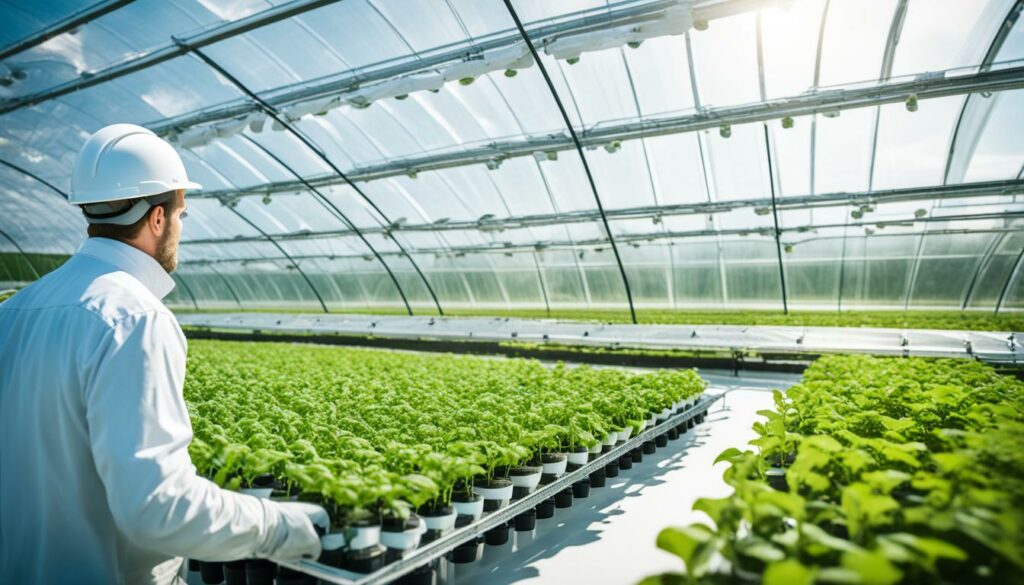
These methods are not only good for the earth but also keep farms alive for the future. Using smart technology and sustainable methods is vital. It helps us feed more people while protecting the planet for our kids.
In today’s changing agriculture world, smart practices are key. They boost both productivity and sustainability. The use of digital tools in farming brings in new, better ways to work.
Using remote monitoring and management changes how farmers run their farms. Thanks to sensors and IoT, farmers get instant updates on soil, crops, and weather. This quick info helps them make smart choices fast, which improves their crops and farm.
This tech also brings ways to automate tasks like watering and fighting pests. This helps the planet by using less water and harmful chemicals. It fits big goals like the FAO’s drive to make farming more sustainable.
Automated machines are also changing agriculture. They handle jobs from planting to packaging. This cuts labour costs and makes everything run smoother, boosting farm productivity.
These machines are not just cool; they’re smart too. They can, for example, spot sugar beet damage. They keep working well even if the weather changes. With the help of blockchain, they make the food supply chain more transparent and safe.
Smart agriculture is growing fast. It’s making farming greener, more effective, and exciting. It’s clear – digital tools are the future of farming.
With the climate changing, we need to improve agriculture. This method uses smart farming to help our plants and animals cope with changing conditions. Agriculture in the U.S. is a big source of greenhouse gases. So, farmers need to adopt new methods quickly.

Professor Stephanie Yarwood’s NASA-funded project looks at nitrogen emissions from farms. It uses satellites to find the main spots where nitrogen releases happen. This could help us cut down on harmful gases. Also, Professor Richard Kohn’s work on feeding cattle algae aims to reduce their methane output.
Saltwater creeping into farm areas is a big problem, as Kate Tully and Rebecca Epanchin-Neil found. They noticed more salt in fields in Delaware, Maryland, and Virginia. This is causing big losses for farmers, especially corn growers.
| Issue | Impact | Adaptive Technique |
|---|---|---|
| Greenhouse Gas Emissions | 10-11% of U.S. total emissions | Satellite data for emission “hot spots” |
| Methane from Cattle | Nearly 50% of agriculture’s emissions | Algae-based feed alternatives |
| Saltwater Intrusion | Doubling of salt patches (2011-2019) | Giant Miscanthus in salt-affected soils |
We’re trying out Giant Miscanthus on salty lands, and it seems to be working. Using GPS and drones in farming is making us use resources better. Plus, things like conservation tillage and cover crops are making our soil healthier and saving water.
As half of the land is for farming, we must grow more food without hurting nature. Using better seeds, rotating crops, and growing different plants together are helping. These methods protect the land while feeding more people.
Farmers are helping each other to learn how to deal with the changes. Knowing the weather is very important, so many use apps for accurate forecasts. Making sturdy buildings on farms can help protect against bad weather.
Staying informed with training on smart farming is key for the farmers. The government is supporting and promoting ways to farm sustainably. This includes helping when bad weather strikes and finding better seeds that can survive tough conditions.
Agriculture is moving ahead with cool new ideas. New farming methods like vertical farming, hydroponics, and aquaponics are changing the game. They are showing us new ways to grow food more effectively.
Vertical farming is super cool and new. It stacks plants on top of each other to save space, perfect for cities. Bowery is a leader in this. They use smart technology to look after their crops. This way, they get more food without using up more land.
Hydroponics and aquaponics are also making waves. In hydroponics, plants grow in water rich with nutrients. This way, they don’t need soil and grow faster. On the other hand, aquaponics join growing plants with raising fish. They help each other out, creating a balanced system.
Both these methods save a ton of water and cut down on chemicals. They’re efficient and better for the planet, making farming more sustainable.
| Technique | Advantages | Key Players |
|---|---|---|
| Vertical Farming | Optimal use of space, year-round production, reduced food miles | Bowery, AeroFarms |
| Hydroponics | Efficient water use, no soil needed, faster growth | Hydrofarm, Freight Farms |
| Aquaponics | Integrated farming, sustainable water use, dual crop production | Naturally Aquaponics, Aquaponic Lynx |
In the end, these new farming methods are helping us do better. They make farming efficient, use fewer resources, and help the environment. Looking forward, these techniques will lead to a more sustainable and successful farming future.
Agricultural automation systems are changing the way we farm. The increasing use of robotics in agriculture marks a move to more advanced tech solutions. These changes help tackle big challenges. For example, we need to produce more food for the growing global population, expected to reach 9.3 billion by 2050.
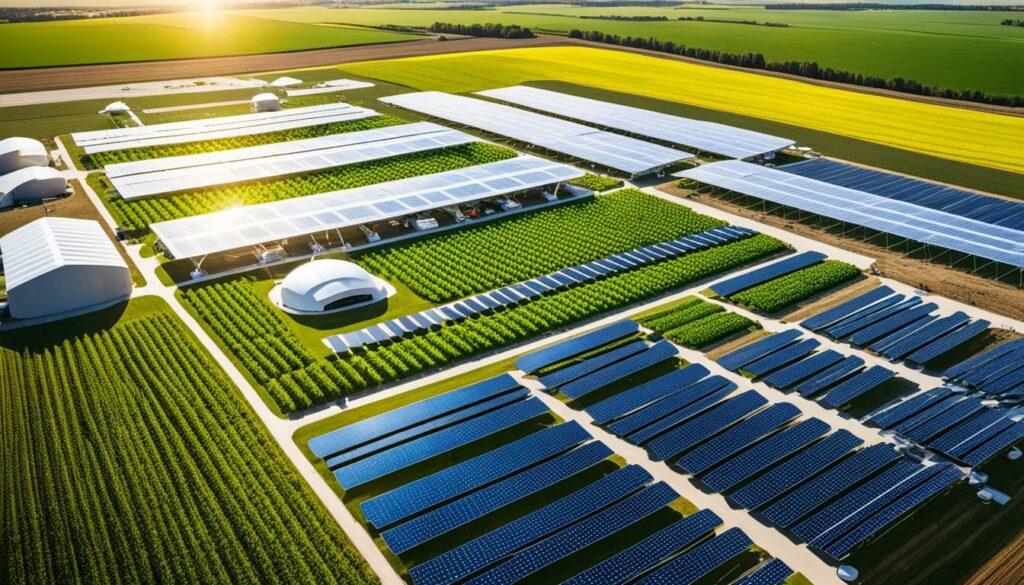
Future farming trends show how key automation is in farming. The AI in Agriculture Market is set grow from $1.7 billion in 2023 to $4.7 billion by 2028. This boost is essential for increasing farm efficiency. Tools like the LaserWeeder by Carbon Robotics help a lot. It can kill 5,000 weeds in a minute, lowering weed control costs by 80%.
Robotics in agriculture also fix problems with not enough workers. More than half of farm costs go to paying workers. But, a single strawberry-picking robot can work a 25-acre field in just three days. It does the work of 30 people. This isn’t just about saving money. It’s also about making farms work better.
Using automated farming systems saves a lot of resources. For example, it’s found that farm automation can cut pesticide use by 90% with computer vision. CropX solutions cut down water use by 57% and fertiliser use by 15%. They also boost yields by up to 70%.
But, there are issues with adopting these new techs. High prices and technical problems, especially in developing nations, can be tough to overcome. Yet, the good these changes do is huge. That’s why using agricultural automation is vital for farming’s future.
| Aspect | Impact |
|---|---|
| AI in Agriculture Market Growth (2023-2028) | $1.7 billion to $4.7 billion |
| Labour Cost Percentage in Farming | Over 50% |
| Water Usage Reduction with CropX Solutions | 57% |
| Weed Control Cost Reduction with LaserWeeder | Up to 80% |
| Global Population by 2050 | 9.3 billion |
Looking forward, using agricultural automation systems more will boost not just crop yields but also help farming be sustainable. This is key for the future of agriculture.
The world’s growing population means we need more food. This has highlighted the need for new solutions in farming. Exciting startups are leading the way by bringing new technologies to agriculture.
Marble Technologies shows how modern farming can be with data-driven solutions. They use AI and software to make farming more efficient and eco-friendly. This move towards precision agriculture is a big change.
Nave Analytics is changing how farmers use data. They use machine learning and the Internet of Things (IoT) to collect and process farm data. This helps farmers make smarter choices for better crop growth.
Grain Weevil is changing how we manage grain with new robotic technologies. This startup focuses on making handling grain safer and more effective. Their work puts them at the forefront of innovation in the agricultural tech industry.
| Startup | Focus Area | Key Innovations |
|---|---|---|
| Marble Technologies | Automation and AI | Data-driven automation for precision agriculture |
| Nave Analytics | Data Analysis | IoT and machine learning for farming insights |
| Grain Weevil | Grain Management | Robotics to improve grain bin management |
These startups are proof that agritech is rapidly growing. With global food needs increasing, their smart farming solutions are key. They play a vital role in making agriculture both sustainable and efficient for the future.
Case studies in agriculture are eye-opening. They teach us how new farming ways are changing the field. At an Innovation Fair in Rome, key sustainable farming achievements were celebrated. These included breakthroughs in crops, animals, fishing, aquatic farming, and trees.
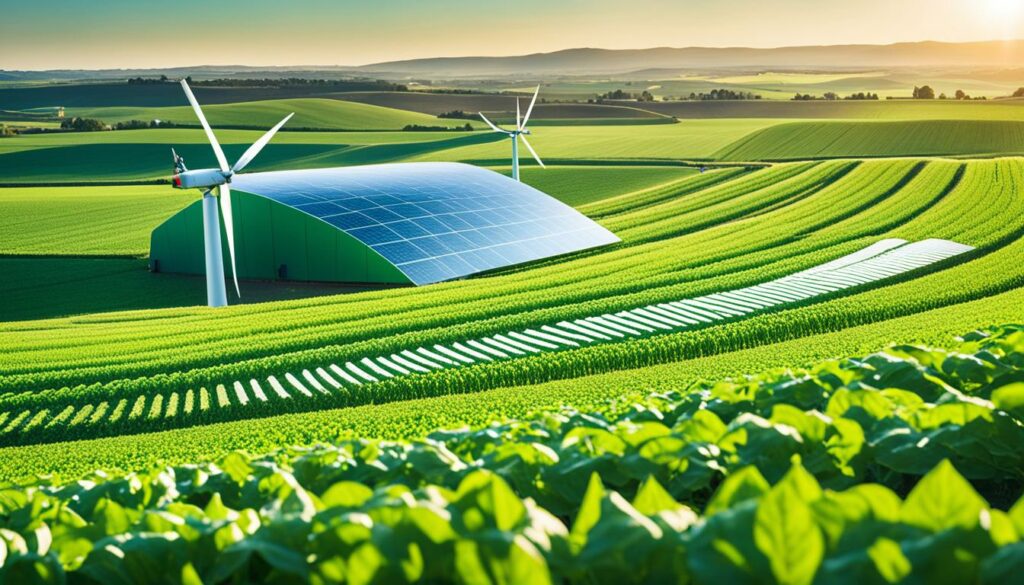
The H2Grow project uses simple hydroponics to grow food. It’s active in nine places, helping 5000 people. Notably, 75% of those helped are women. Projects like this are crucial. They help us fight climate change and ensure we have enough food and resources.
Then there’s the DTMA project for maize in Africa. It focused on areas regularly hit by drought. Farmers in Zimbabwe saw their yields go up by 600 kg per hectare thanks to this effort. Many maize types were developed, 15 for Zimbabwe alone. At first, farmers doubted, but after seeing the results, they embraced the new maize.
Nigeria deserves a mention too. Its cereal production grew from 7.8 million tons in 1960 to 25 million tons in 2016. This shows a huge jump in farming success. It’s thanks to new techniques and hard work in agriculture.
| Country/Region | Innovation/Project | Impact |
|---|---|---|
| Zimbabwe | Drought Tolerant Maize for Africa (DTMA) | Yield increase of over 600 kg per hectare |
| Nigeria | Total Cereal Production | Increased from 7.8 million tons (1960) to 25 million tons (2016) |
| Global (9 countries) | H2Grow Project | Reaching 5000 people, 75% female participants |
These cases highlight the good from mixing agricultural innovation with eco-friendly methods. They stress the need for more change in farming. A change that tackles today’s problems and prepares us for a greener, more lasting future.
Precise solutions with high-tech tools are changing the way we manage crops. They use AI in farming and robots to remove weeds. This makes our fight against pests and weeds better for the environment and more effective.
AI is transforming how we handle pests in farming. Companies like John Deere and Blue River are leading the way with smart sprayers. These sprayers can find and attack pests without using too many chemicals. This is better for nature and helps farms produce more.
Removing weeds with robots is an important part of modern farming. Greeneye Technology and One SmartSpray have made systems that can tell weeds from crops. This means they can spray only the weeds, which is good for the environment and farming.
A project called PlantMap3D, with the help of GROW and PSA, is making it easier to see and manage weeds. They use cameras to track weed types and amounts. This will be available for everyone to use by 2028, making weed control smarter.
There is also the National Ag Image Repository. It’s a big public database of pictures. It helps teach machines how to spot weeds and different crops quickly and accurately.
Using this advanced farming tech helps us farm better and more eco-friendly. It cuts down on bad chemicals, saves our earth’s resources, and makes our surroundings healthier. This high-tech and precise way of farming is kind to the planet and good for farming.
The focus on soil health and precise irrigation is growing. The U.S. Department of Agriculture (USDA) gave $25 million to help with this. Through the Conservation Innovation Grants (CIG) On-Farm Conservation Innovation Trials, 18 projects have started. Sixteen of these are for people often overlooked.
In Colorado, Trout Unlimited and eight farmers are using smart technology for better water use. They’re focusing on areas over 5,500 feet high. This project uses LoRa for improved flood irrigation. It’s a big step in making farming smarter, from California to North Carolina.
In California, almond growers are being encouraged to use deep root and smart drip irrigation. In North Carolina, they’re looking into reducing harmful nitrogen emissions. These efforts help places with low soil quality and high heat. The Nature Conservancy is also working in Michigan and Wisconsin. There, they are reducing methane gas from dairy cows. This shows a strong push for better soil health and water use.
More groups are joining in. For example, Handsome Brook Farm is getting its eggs from climate-smart methods in Kentucky. They are focusing on good manure use and pasture care. The Xerces Society is helping pollinators from California to Washington. This is part of making agriculture better for the climate.
Everyone is working together to make soil and water use better. The goal is to help against climate change and save our land. By using smart technology and careful water use, these projects are leading the way for the future.
For more info on these efforts, check out the USDA’s official announcement.
Future farming will see high-tech solutions like AI and IoT used in fields. This includes tools for precision farming and new methods such as vertical farming. The goal is to make farming more sustainable and productive.
These new technologies help produce more food to feed the world. They also make sure farming doesn’t harm the environment too much. This way, the Earth’s resources are used wisely.
New ways of farming help fight climate change by using less water and fewer chemicals. They also embrace farming methods that are good for the environment. This reduces the harm farming does to our planet.
AI is changing farming by making processes more efficient. It can predict future yields and help manage pests. AI brings big improvements to how farming is done.
The IoT helps farming become more digital. It includes smart sensors and automated machines. This technology boosts farm efficiency and helps save resources.
Precision farming uses the IoT and high-tech tools to run farms better. It focuses on keeping an eye on yields and making sure resources are used well. This improves how much food farms can grow.
Sustainable farming, like using precise watering systems, limits water waste. It supplies plants with just enough water, avoiding overuse. This kind of farming is key for the planet’s future.
Remote agriculture technology lets farmers check on their land from anywhere. It helps them make smart choices, improves efficiency, and can stop problems fast. This leads to better use of resources and more food grown.
Automation in farming, including robots, is changing how farms work. It boosts efficiency, cuts the need for manual work, and makes processes more precise. These changes help farming grow and be kinder to the environment.
New ways to farm, like growing crops indoors or without soil, save space and use less water. Scenarios include vertical farming, hydroponics, and aquaponics. These methods are changing the agriculture game.
Leading the way in farming tech are startups such as Marble Technologies, Nave Analytics, and Grain Weevil. They bring data-focused solutions to agriculture. These new technologies are set to make a big difference.
Farming case studies show how new and sustainable methods can work. They share what has been achieved in the field. This knowledge helps other farmers do better too.
For pests and weeds, there are smart pest control and robotic weed systems. These high-tech solutions target issues directly, saving on chemicals. They’re good for the crop and the environment.
Good soil and smart watering use are key to making the most of farms. By closely monitoring the soil and water, farmers can grow more food without harming the land. This is a key part of sustainable agriculture.